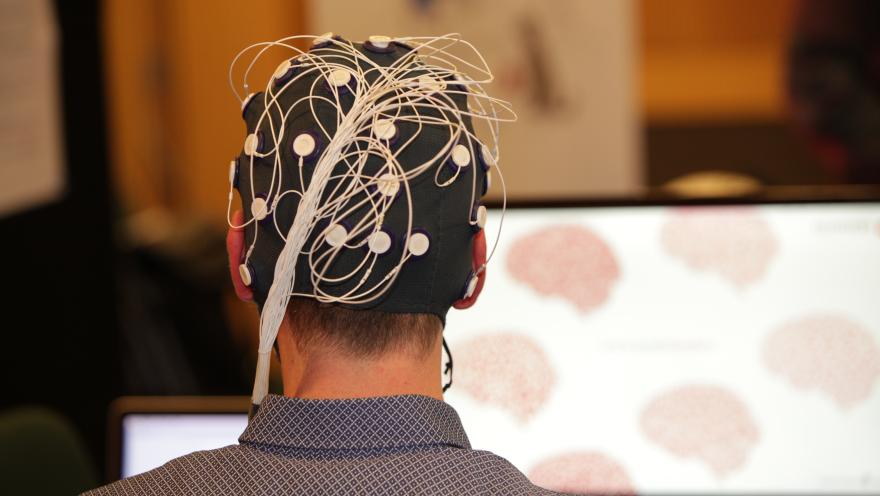People living with ALS eventually lose the ability to speak to their loved ones and friends. In partnership with Prize4Life, we initiated the ALS Assistive Technology Challenge to improve the lives of people with ALS. The Challenge culminated last December in Dublin during the ALS/MND International Alliance Meeting, when we brought together five top assistive technology teams to find the best prototype designed to help people living with ALS communicate with ease. The key prize criteria were that the technology is adaptable to the changing phases of the disease and the teams had a solid business plan to bring the technology to market in a reasonable time frame. Importantly, people with ALS were engaged in the development and review of the Challenge.
At the end of the day, there were two winners – Dr. Peter Desain and team of The Donders Institute for Brain, Cognition, and Behavior in the Netherlands and Dexter Ang and team of Pison Technology at Massachusetts Institute of Technology. We recently sat down with the two winners to learn about the progress they made in the past year.
Thank you for joining us today and for the update. We are excited to hear what you have been up to! First, can you give us an overview of your technology?
Dexter Ang (Pison Technology)
It is a wearable wrist worn device that captures nerve signals and micromovements to control computers and home devices.
Dr. Desain (Donders Institute)
People living with ALS in later stages often rely on devices for communication. Eye tracking is the most common method, but around one third of the people living with ALS are unable to use eye-tracking. This is either because of loss of head movement, or due to interference of glasses, contact lenses, or long eye lashes.
Our technology involves a Brain-Computer Interface (BCI) for people living with ALS. This means that brain signals are measured. For this the non-invasive electro-encephalogram (EEG) is used using a cap on the head that measures little electrical waves from the brain. Crucially, these brain signals inform the computer about what the person living with ALS sees.
Current BCI’s are slow, unreliable, and not user friendly. However, in our lab a scientific breakthrough made it possible to develop a BCI that is quick and reliable. This is how it works: the person attends a computer screen. On the screen letters are flashing, each with their own pattern. The user needs to attend to a specific letter (for about one second), and the computer can ‘read’ – via the interface with the person’s brain – which flash-sequence, and thus which letter it is. In this way, by attending, letter-by-letter, the computer can spell out what the user would like to say.
How does your technology help people living with ALS?
Dexter Ang (Pison Technology)
Can be used throughout disease progression. It is intuitive and easy to use 24/7. It can be customized to different parts of the body.
Dr. Desain (Donders Institute)
It helps people in later stages of ALS to communicate with their relatives and medical staff. Our BCI needs no training time, so it is ready to use and plug-and-play. In this way, our assistive technology gives a voice to people living with ALS.
Also, the BCI technology provides the opportunity to gain environmental control. For example, by attending to the alarm button, it may be activated. Or, by attending to some other feature, the lights may be turned on and off, or the temperature may be lowered or raised. In this way, it helps the users to be more autonomous and in control than without this technology.
What progress has been made?
Dexter Ang (Pison Technology)
We were awarded small business grants from the National Science Foundation and National Institute on Disability, Independent Living, and Rehabilitation Research for $325,000. Phase 2 of this project could possibly cost $1.8 million. Investors include the technical director at Oculus and the head of Neurosurgery at Harvard Medical. The first prototypes for enterprise and military customers will be tested in Q1 2018.
Dr. Desain (Donders Institute)
The ALS Association and the ALS Foundation Netherlands cooperated to finance our project, which officially started on September 1, 2017. It is our goal to apply scientific knowledge to bring a user-friendly, fast and reliable tool to the market. To achieve this, we work together with several public-private partnerships including the Radboud University in the Netherlands, its spin-off MindAffect, ALS Liga Belgium, the hospital Radboud UMC, and some hardware and assistive technology companies. We made a flying start. In October we had already 10 people on the pay-roll (paid by the subsidy and from investors) working towards this goal. We elaborated the method by inventing a new kind of headset. We then prepared for testing our tool with people living with ALS and conducted market research. Thus, all preparations are in place for our 2-year project. The technical side of our tool has improved greatly, allowing calibration-free use and a reduction in the number of technical parts needed. Hence, as we envisioned, our product will become easy to use, for daily life.
Thank you both for taking the time to give our community an update. We are so happy to see that both of you have made significant progress in only one year and look forward to hearing more exciting news from you in the future!
With your support, people living with ALS will be able to better communicate with their loved ones, friends, and healthcare providers, giving them a better quality of life. Donate today to help us further support assistive technology companies like Donders Institute and Pison Technology, who work hard every day to bring new, exciting technologies to people living with ALS.


Join the conversation. Please comment below.